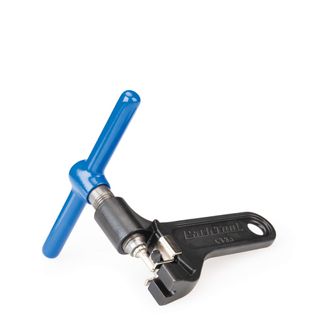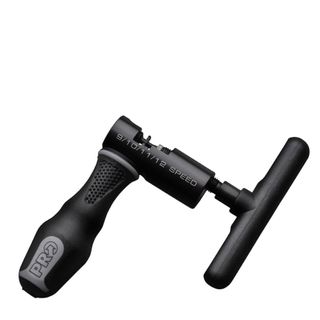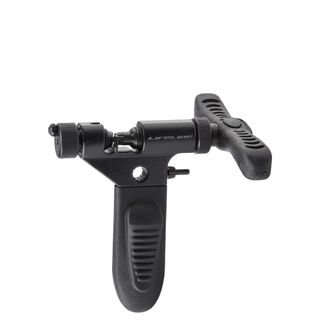Best workshop chain tools 2024 rated and reviewed
We put workshop quality chain tools to the test to see which is worthy of your money

Best workshop chain tools 2024
Shortening or repairing a chain is a job that simply cannot be bodged; it requires a chain tool to take the rivet out and then replace it. Whilst some of the best multi-tools include a chain tool, these are made for occasional, roadside use rather than frequent workshop deployment.
The best workshop chain tools are tougher, easier to use and offer more functionality than a multi-tool as well as being more ergonomic to use. They should also offer compatibility with a wider variety of chains so that they can be used with the best road bikes as well as the best commuter bikes.
Although 'quick-links' have made rejoining a chain easier than previously, there are still occasions and types of chain that need joining with a rivet, so a good chain tool that can connect as well as break is still a home workshop essential.
The quick list

Best overall
The Topeak All Speeds Chain Tool is easy to use, comfortable in the hand and includes both a spare pin and a chain hook stowed in the handle. It works with a wide variety of chains too, so deserves a place in your workshop.

Best looking
A tool's aesthetics don't matter much as long as it works, and the Damselfly Universal does the job perfectly well, but it is its angular looks that are particularly striking. It doesn't offer some of the extra features, like the ability to adjust a tight link, but it does the basics and looks rather fine whilst doing them.

Best for durability
Compatible with most chains and well made, you can be sure that the CT-3.3 make short work of most jobs. It does lack a few extra features, but Park Tool kit is made to last, making it a very sound choice for home or professional mechanics alike.

Most compact
Size doesn't matter much for workshop tools, but there is a definite beauty in the PRO chain tool 9-12's nicely machined, compact design. It covers 9 to 12-speed chains but nothing more and it does lack the ability to adjust a tight link but the smooth action makes using it a cinch.

Best ergonomics
With a classy wooden handle and very smooth, powerful action, the Lezyne Classic Chain Drive is a real pleasure to use. It has good compatibility and can adjust a tight link, and there is a spare pin in the handle. Being picky, the pin doesn't spin though.

Best value
LifeLine's Pro Chain Rivet Extractor has an 'S' shaped handle that fits nicely into the hand and has all the features that you could wish for. It can be a little bit fiddly to use though with various screws that need adjusting for different tasks. It works well though and offers excellent value for money.
Best overall


Showing the 2nd tight link bridge

Using the chain hook
1. Topeak All Speeds Chain Tool
Our expert review:
Specifications
Reasons to buy
Reasons to avoid
The Topeak All Speeds Chain Tool will accommodate chains from a wide singlespeed chain (1/8" type) to a 12-speed chain and it can also peen the hollow rivets on Campagnolo 11 and 12-speed chains. The tool is nicely made and incorporates all of the features that I would expect to see in a workshop tool.
The hollow body handle stores a spare pin and the chain hook. The pin in the driver handle is a spinning type allowing the tool to drive a rivet out without adding a rotating force onto it; it's a nice engineering touch. The pin stayed true throughout the test.
Using it with a selection of different width/speed chains I found that it drove rivets out very easily due in part to the leverage afforded by the sliding handle. I really liked being able to see how far out the rivet had been pushed so as to not push it completely free. This matters if you want to rejoin the chain in the old way. When rejoining the chain it was easy to see when you had centralised the rivet ready for the chain to be used. In the event of a tight link, there is a second chain bridge allowing the quick and easy loosening of this.
When using a Shimano rivet the tool has a neat function at the end of the driver handle. It has a chain pin breaker slot which is a bit neater than my usual method using pliers!
I enjoyed using this tool and liked the clear visibility of being able to see exactly where the rivet was in its travel. The smooth power from the handle was great and I liked having all the functions contained in the one tool. Very nice design.
Best looking


Birzman Damselfly Universal
Our expert review:
Specifications
Reasons to buy
Reasons to avoid
The Birzman Damselfly Universal is a really striking-looking tool with its angular styling. It has a sprung loaded chain bridge which allows any (1-12-speed) chain to be correctly set before having the rivet pressed out.
In use, I found that it had a nice action and needed minimal pressure from the thumb and first finger to rotate the pin handle. It was comfortable to hold the body handle and it replaced a rivet nicely too. You can use the top of the slot to break a Shimano connecting rivet off. Neat! However, it doesn't loosen a tight link as there is no second bridge.
If you just want to set a chain to the correct length and rejoin with a quick link, then this tool does that job with style and panache. However, for me, the lack of a second bridge is an issue.
Best for durability


Park Tool CT-3.3
Our expert review:
Specifications
Reasons to buy
Reasons to avoid
The Park Tool CT-3.3 is made from steel and features a rugged design with its iconic blue adorning the pin handle. I think it's fair to say that you'd expect years of use from this tool especially as many bike shops use Park Tools daily.
It will accommodate all chains from wide singlespeed to 12-speed as well as SRAM AXS 12s, Campagnolo 13s and even half-link chains. Whilst it will work with Campagnolo hollow link chains (11-13s) it is unable to peen the reinstalled rivet.
Similar to the Birzman it has an adjustable chain bridge to automatically set the correct distance for each chain type. In practice, it seems a bit loose initially but once loaded up with a chain it settles in correctly and I had no issues with it during the test. In use, it has good power and pops a rivet out with ease.
Reinstalling the standard and Shimano type rivets was equally straight forward and I used the slot to snap off the Shimano rivet - a bit of an unofficial feature maybe. I liked that it was very easy to see how far out the rivet was, which helped with the removal and resetting of it.
The pin is a fixed type and replaceable but not included. Park do supply them as Part No. CTP. Also, there is nowhere on the tool to store the spare pin.
Like a few of the tools here, it was unable to deal with a tight link as there was no second bridge. Maybe it's now all about quick links, which I do like and use, but I'd still prefer the option...
Most compact


PRO Chain Tool 9-12
Our expert review:
Specifications
Reasons to buy
Reasons to avoid
The PRO chain tool 9-12 is the smallest tool in this guide but don't let that put you off as it is jewel-like in its machining. The writing on the body is very precisely etched and handily states its chain type capability.
Despite shortish pin and body handles there was plenty of leverage and the threading was some of the smoothest on test despite being the smallest diameter. The rivet was easy to pop out and reset, and again I had a clear vision of where it was in the process ensuring that I didn't completely remove it by mistake.
I felt that the rotating pin helped with the smooth action of this tool. At the back of the chain support, there is a hole to release a rivet and it worked to break off the Shimano-type rivet but there was no ability to adjust a tight link though.
PRO states that this tool has a "misuse prevention feature" only allowing it to be used with 9 to 12-speed chains. If you want to break a 1-9 speed chain you need to use their other model.
It worked very nicely with the 11-speed Shimano chain so I tried it with the narrow singlespeed chain being very careful to check for any compatibility issues. It worked fine. When I tried to set up the wide singlespeed chain it didn't look happy though as it was unable to sit squarely in the chain bridge, so I didn't proceed.
If you only want to deal with relatively modern 9-12 speed drivetrains (although it seems to cope with some others) with quick links then there's a lot to like about this tool.
Best ergonomics


Lezyne Classic Chain Drive
Our expert review:
Specifications
Reasons to buy
Reasons to avoid
The Lezyne Classic Chain Drive is a really lovely tool to look at and feels well constructed when in the hand. The wooden handle instantly sets it apart from the other tools in the test. It is the heaviest (just) in the test and also physically the largest, but the leverage from the long pin handle makes it very light in use. In that regard, it is similar to the Birzman tool. You only need to apply pressure with a thumb and first finger knuckle on the handle to drive a rivet out.
In use, the threaded chain support can be wound in or out to set the correct distance needed for the chain to sit correctly in the chain bridge. As the support has a good-sized slot machined in it you can clearly see how far through a rivet is, making the breaking and rejoining of a chain really straight forward. Then, if you encounter a tight link, the support may be wound back making the chain bridge effectively the second bridge.
Lezyne state that the Classic will deal with 8-12 speed chains (but not hollow pin chains) but I tried it using our selection of a Shimano 11-speed chain and connecting rivet, then the KMC Narrow and Wide singlespeed chain (rejoining in the old fashioned way) and had no issues whatsoever.
The pin is replaceable with a spare that is kept in the handle, and whilst it doesn't spin it didn't spoil the experience of using this versatile and powerful tool.
Best value



LifeLine Pro Chain Rivet Extractor
Our expert review:
Specifications
Reasons to buy
Reasons to avoid
The LifeLine Pro Chain Rivet Extractor is a fairly accomplished tool despite being one of the cheapest on test. It is nicely made in steel with rubberized covers for the handles. It can cope with everything from 1 to 12-speed chains. It can also deal with Campagnolo hollow rivets apparently.
The little threaded part (kept on the chain support - on far left of the above picture) may be threaded in to chain support center to allow a Campagnolo hollow link to be installed. I was unable to try this feature in our test, however.
The LifeLine Pro worked well with our sample chains and I found the 'S' shaped pin handle particularly nice to use. It was plenty powerful enough to extract a rivet and then rejoin a chain. However, I found it awkward with regard to knowing how far through a rivet had been pushed as the chain support obscured my vision. Whilst there is a knurled ring on the pin handle thread to allow you to set the depth, it took a while to calibrate it.
If you only use one width of chain I suppose it would matter less but I found with our selection of 3 different chain widths (5.5mm, 7.4mm and 8.65mm) it was a bit fiddly. Also, when rejoining the Shimano 11-speed chain with its connection rivet, I found that the chain support had to be backed right off to allow the protruding rivet to be released. The tool could then easily snap the rivet end off though.
A solid tool
KMC Reversible Chain Tool
Our expert review:
Specifications
Reasons to buy
Reasons to avoid


The KMC Reversible Chain Tool is the second smallest and lightest on test. The body and handle are made from steel whilst the body handle has a rubberized 'Kawasaki' green cover. The pin spins and it can swapped around if a pin breaks.
I found with the first couple of chain breaks that the rotating handle felt slightly graunchy compared to the other tools on test. I greased the thread a little and it became much smoother in action. Something to bear in mind.
It dealt with the de-riveting and re-riveting well apart from a couple of things of note. Firstly, when installing a Shimano rivet it was really difficult to remove the chain from the tool as the protruding end of the rivet was held captive in the slot (see pic 2 above).
There is a cover to the end of the slot that gets in the way. It took some waggling to extract the chain and once released the rivet end could be snapped off. The other issue is that if you wrap your fingers around both the body handle and the pin handle your knuckles clash as there is not enough room between the handles.
The sliding pin handle did give good leverage though and it accommodated all the test chains easily. However, the lack of a second chain bridge meant that I couldn't adjust a tight link... again! Spotting a theme here?
I haven't been able to see exactly what is reversible about it. It may be that the spare pin being double-ended is reversible? Each end measures the same length... So whilst a spare pin is included and is not storable on the tool, it does store a spare on the 'reversible' pin.
Advice
Tech terms
You can trust Cycling Weekly.
Pin driver handle: The handle that you rotate to bring the pin to the rivet and then push the rivet through the chain
Body handle: The handle that you hold to steady the tool
First chain bridge: The most used section to support the chain allowing the accurate alignment of the rivet then to be driven out
Second chain bridge: Used to loosen a tight link
Anvil: used to peen the hollow rivets used in some Campagnolo 11, 12 & 13-speed chains. Not within the scope of this test but some tools have the ability
Conclusion
All of the tools here were very capable of driving a rivet out of a multi-speed chain, so If you are 'just' looking to do that task and then using a quick link. you won't be disappointed. The differences start to show themselves when dealing with older style chains and joining practices, alongside ease of use. Although they can be initially expensive, a versatile and quality chain tool will repay you with reliability and durability over time. It will make the job more enjoyable too!
The Topeak was my favorite tool with its ability to deal with everything on test, it was well made and is keenly priced. It was closely followed by the more expensive Lezyne tool. There was little to separate the Park Tool, Birzman and PRO tools and really it was just the inability to loosen a tight link that let them down. The LifeLine tool is able to deal with nearly every chain type but is a little fiddly to use/set up and finally, the KMC's handles are too close together for me.
How we test
Firstly a chain tool must be able to accurately and reliably break a chain by removing a rivet, secondly it should be able to refit a rivet. Then it should be able to loosen a tight link, and finally should the pin break on the tool it should be replaceable. Otherwise, the tool would be rendered unusable.
Next there are some 'nice to haves' namely:
Does the pin spin? When a rivet is moved in or out of a chain bushing we want the pressure applied in one direction, across the tool. With a static pin, you also apply a rotating force to the rivet as well. It's not a deal breaker but it is a nice engineering touch.
Is the tool supplied with a spare pin, and can the spare be stored in or on the tool? It saves it from being lost or mislaid.
Finally, does it have a chain hook? This stops the chain from being under tension (from the derailleur) when removing a rivet or quick link and firing important bits of chain across your workspace when you've forgotten to drop the chain off the front ring to detention the chain.
Initially, all tools were used to break a Shimano CN-HG701 11-speed chain (11/128" type 5.5mm outer width) and then to connect it back using a Shimano 11-speed connecting rivet (CN9000). If able to, the guide part of the rivet was snapped off using the tool and finally a tight link was loosened.
Then, I used a narrow KMC Z610HX singlespeed chain (3/32' type 7.4mm outer width) and drove the rivet out, then rejoined the chain and finally loosened any tight links.
And lastly, a KMC Z1 wide singlespeed chain (1/8" type 8.65mm outer width) was tried using the same process as before.
If a tool was unable to accommodate a chain in the bridge it wasn't tried. The chain had to sit down correctly in the bridge and sit squarely in the tool.
Get The Leadout Newsletter
The latest race content, interviews, features, reviews and expert buying guides, direct to your inbox!
Over 40 years cycling in a variety of disciplines including road riding, commuting, a self-supported Land's End to John o' Groats trip, XC mountain biking and several Polaris Challenge two-day events. Adventure, escape and fun are the motivations for my riding. I also love bike and kit design and have fillet brazed a couple of framesets using Reynolds 853 steel tubing for myself. A very satisfying experience to ride your own bespoke bike!
Height: 180cm
Weight: 66kg
-
 Remco Evenepoel goes on first outdoor ride since horror crash, hints at Tour de France on Strava
Remco Evenepoel goes on first outdoor ride since horror crash, hints at Tour de France on Strava'On my way back' says the Belgian, as he builds back up to Tour de France form with almost-100km ride
By James Shrubsall Published
-
 Four weeks after breaking arm, Lizzie Deignan set to start La Vuelta Femenina
Four weeks after breaking arm, Lizzie Deignan set to start La Vuelta FemeninaBritish rider to line up at eight-stage race on Sunday, less than a month on from crash at Tour of Flanders
By Adam Becket Published